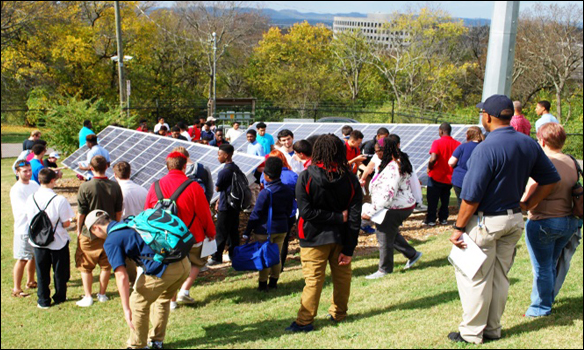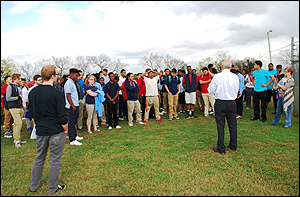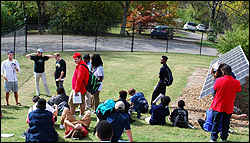
When Whites Creek High School students and teachers looked for a ground-mount solar cell installation to visit, they didn’t have to go far. It’s a mere 15 miles to the Vanderbilt School of Engineering’s wind-solar energy demonstration site at the top of Love Circle, one of the highest points in Nashville.
The Vanderbilt wind-solar alternative energy site offers a 4.8 kW (kilowatt) solar array and a 3kW wind turbine. The site was set up in 2012 by Professor Amrutur Anilkumar in collaboration with Nashville Metro Water Services. It has been used as a one-stop field teaching ground for wind and solar renewable energy facilities for both Vanderbilt engineering students and students from Nashville schools.

Eight teachers and 70 students representing Whites Creek’s Academy of Alternative Energy, Sustainability and Logistics explored the site Nov. 4 as part of a “field-based experiential day” of learning. The academy is a three-year program in which students study wind and solar energy, biodiesel and ethanol fuels, and nuclear energy, among other topics, and they have hands-on experience on a farm adjacent to the school.
In 2014, the academy won the Governor’s Environmental Stewardship Award for Excellence in Energy and Renewable Resources, a high-level state environmental prize that represents the academy’s efforts in building a future in alternative fuels.
Jason Carney, an energy consultant with the Tennessee Department of Environment and Conservation, works with the academy as part of a graduate school project, and joined the students and teachers at the Love Circle site.
“I’m surveying how interested these students are in careers in renewable energy by exposure to photovoltaic (PV) and green economy curriculum, site visits, and the institutions and professions that support the industry,” Carney said.
Students got a rundown of the PV and turbine siting, energy estimation, facility design, installation, operation and other engineering issues related to the Love Circle site. Students were also referred to the public access site – VU/MWS Renewable Energy Showcase – to follow-up on the details.
“We broadened the scope of solar energy capture by introducing space-based solar energy capture and the latter concept led to multitudes of questions as the students followed handouts for both of these methodologies,” said Anilkumar, professor of the practice of mechanical engineering and director of the showcase wind and solar facilities.

Three Vanderbilt engineering students also were on hand to take questions and encourage pursuing engineering as a career. They were mechanical engineering seniors Robb Rutherford and Matthew Kelley, and computer engineering senior Mitchell Masia.
“I am very appreciative of Dr. Anilkumar and his students for being so flexible with their time and engaging with the students during our visit to the Love Circle site. I believe interest, engagement and real learning will follow when students are able to combine hands-on work with meeting and talking with professionals who do that work every day,” Carney said.
“The teachers were very interested in the presentations and were sure to take the experience back to their classrooms,” Anilkumar said. “Several students found it inspiring to talk directly with the engineering students about engineering as a career.
“It is extremely important that more young people from all demographics become familiar with the increasing interest in alternative energy technology. This technology has the potential to alleviate, if not solve, many of the world’s needs for reliable, sustainable power sources, yet much of our population have little to no concept of that possibility,” said Willie Sweet, Whites Creek academy teacher who specializes in automotive technology.
Sweet was joined by seven other teachers, Rayna Eberhart, Leigh Siegfried, Roosevelt Williamson, Rachel Amescua, Thommye Davis, Suzanne Dixon and Savington Nickens.
Sweet said teaching students about technology is one thing, seeing it in action and talking to experts “makes it real.”
“The evidence is in the many questions our students asked, and have continued to ask, since the visit to Love Circle,” Sweet said. “From experiences such as this, we may be able to inspire future innovators in the alternative energy field who will create more efficient and cost-effective technology to benefit all mankind.”
Contact:
Brenda Ellis, (615) 343-6314
Brenda.Ellis@Vanderbilt.edu
Twitter @VUEngineering